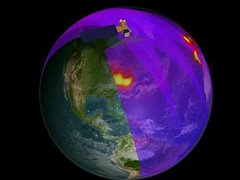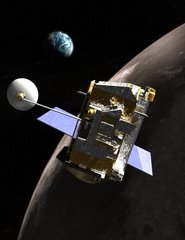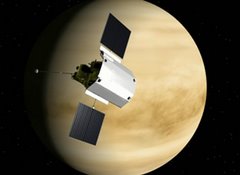
Day 2 of the the Discovery @15 Conference began with the "Development and Project Management" session. Right now the quote of the panel is "Everyone draws a good org chart" (Paul Gilbert) the question is who are the personalities driving the project. The chemistry of project team is a key to success. Important keys to early Discovery Mission success "Focused Science" and "Minimize Risk" that changed the paradigm of Solar System exploration.
Now back to tweeting from Discovery @15
Next up will be Wes Huntress "Discovery- on the Road Again"
Wes Huntress "the father of the Discovery Program" http://tinyurl.com/2aho36
Discovery -- lower cost...using smaller launch vehicles and smaller spacecraft and finding new ways of doing businessMars Observer was to be the 1st low cost mission before Discovery..it ballooned in cost and disappeared at Mars Orbit insertion
Mars Observer link http://mars.jpl.nasa.gov/mi... (I was supposed to work on day from MO..changed my career path)
The loss or Mars Observer taught us we had to manage risk..one way "test, test and test"
New model NASA would "buy whole missions from the science community" first time missions were competed
There hasn't been a full mission selection in Discovery in 5 years...we were supposed to launch every 18 months.
The loss of the Delta II launch vehicle will hurt Discovery
Huntress: "we found by experiment the limits to "better, faster, cheaper" and the pendulum has swung in wrong direction
Next up the EPO session
All Discovery mission proposals must include and Education and Outreach planThe first presenter in Shari Asplund EPO lead for the Discovery Program http://discovery.nasa.gov/education
A new addition to EPO for Discovery is "student collaboration" ways to involve high school and undergraduate students
many missions participate in Master Educator Progams...Solar System Educators and MESSENGER Educator Fellows
missions also conduct educator workshops and develop curriculum -reach k-4 thru stories and songs- older kids get involved in mission data
Discovery works with museums, planetariums, networks of amateur astronomers and solar system ambassadors http://www2.jpl.nasa.gov/ambassador/
Jacinta Behne is talking about EPO for the Genesis mission http://genesismission.jpl.nasa.gov/educate/index.html
Jacinta "we need to translate complex content in various ways to meet the needs of our various audiences"
http://genesismission.jpl.nasa.gov/educate/scimodule/cosmic/ptable.html check out the interactive periodic table from the Genesis misssion
Genesis also managed to get a Genesis video on United Airlines flights...
Deep Impact EPO from Maura Rountree Brownhttp://solarsystem.nasa.gov/deepimpact/index.cfm
Deep Impact had Lucy McFadden http://www.astro.umd.edu/~mcfadden/ a science team member as part of the EPO
Maura "You have to be careful the plan has to be cohesive" what do audiences need, what science does our mission bring..who needs to know
Deep Impact EPO built a philosophy and aligned all activities
prepare for the unknowns known unknowns and unknown unknowns advice to EPO leads
next session for Discovery @15 the Complexities of Deep Space Operations
Andy Cheng is now talking about the challenges of NEAR http://near.jhuapl.edu
NEAR was the first planetary mission outside a NASA center...web was new then..first mission to have a website and Andy was an early blogger
check out the videos of the NEAR Eros encounter http://near.jhuapl.edu/Images/.Anim.html
next up Mike A'Hearn the PI for the Deep Impact mission and PI for the Deep Impact extended mission
the impactor on Deep Impact was 1/3 ton 50% copper... the comet overtook the impactor
Check out "Deep Impact-A Smashing Success! http://tinyurl.com/6ksxj
The Deep Space Operations panel is now up--
Deep Impact had more operations issues than anticipated..basically learning to operate the s/c and testing all of the command sequences
Genesis Sample return had the challenge of targeting away from earth til the last possible moment...they had 12 reviews that year
panelist: many of these missions underestimated the operations requirements at the proposal stage
Discovery @ 15 meeting has adjourned!
don't forget to check out the blog http://tinyurl.com/yutyp6












